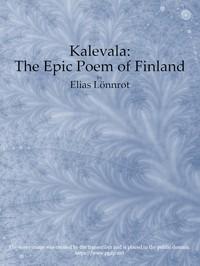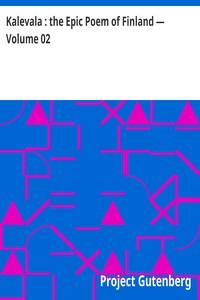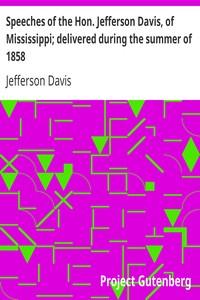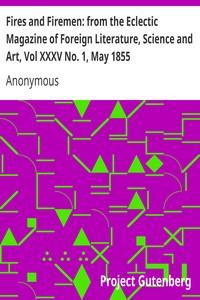|
|
Read this ebook for free! No credit card needed, absolutely nothing to pay.Words: 138752 in 33 pages
This is an ebook sharing website. You can read the uploaded ebooks for free here. No credit cards needed, nothing to pay. If you want to own a digital copy of the ebook, or want to read offline with your favorite ebook-reader, then you can choose to buy and download the ebook.

: Kalevala : the Epic Poem of Finland — Complete by L Nnrot Elias Compiler Crawford John Martin Translator - Finnish poetry Translations into English@FreeBooksTue 06 Jun, 2023 Finland is at present a Grand-Duchy in the north-western part of the Russian empire, bordering on Olenetz, Archangel, Sweden, Norway, and the Baltic Sea, its area being more than 144,000 square miles, and inhabited by some 2,000,000 of people, the last remnants of a race driven back from the East, at a very early day, by advancing tribes. The Finlanders live in a land of marshes and mountains, lakes and rivers, seas, gulfs, islands, and inlets, and they call themselves Suomilainen, Fen-dwellers. The climate is more severe than that of Sweden. The mean yearly temperature in the north is about 27?F., and about 38?F., at Helsingfors, the capital of Finland. In the southern districts the winter is seven months long, and in the northern provinces the sun disappears entirely during the months of December and January. The inhabitants are strong and hardy, with bright, intelligent faces, high cheek-bones, yellow hair in early life, and with brown hair in mature age. With regard to their social habits, morals, and manners, all travellers are unanimous in speaking well of them. Their temper is universally mild; they are slow to anger, and when angry they keep silence. They are happy-hearted, affectionate to one another, and honorable and honest in their dealings with strangers. They are a cleanly people, being much given to the use of vapor-baths. This trait is a conspicuous note of their character from their earliest history to the present day. Often in the runes of The Kalevala reference is made to the "cleansing and healing virtues of the vapors of the heated bathroom." The skull of the Finn belongs to the brachycephalic class of Retzius. Indeed the Finn-organization has generally been regarded as Mongol, though Mongol of a modified type. His color is swarthy, and his eyes are gray. He is not inhospitable, but not over-easy of access; nor is he a friend of new fashions. Steady, careful, laborious, he is valuable in the mine, valuable in the field, valuable oil shipboard, and, withal, a brave soldier on land. The Finns are a very ancient people. It is claimed, too, that they began earlier than any other European nation to collect and preserve their ancient folk-lore. Tacitus, writing in the very beginning of the second century of the Christian era, mentions the Fenni, as he calls them, in the 46th chapter of his De Moribus Germanoram. He says of them: "The Finns are extremely wild, and live in abject poverty. They have no arms, no horses, no dwellings; they live on herbs, they clothe themselves in skins, and they sleep on the ground. Their only resources are their arrows, which for the lack of iron are tipped with bone." Strabo and the great geographer, Ptolemy, also mention this curious people. There is evidence that at one time they were spread over large portions of Europe and western Asia. Perhaps it should be stated here that the copper, so often mentioned in The Kalevala, when taken literally, was probably bronze, or "hardened copper," the amount and quality of the alloy used being not now known. The prehistoric races of Europe were acquainted with bronze implements. It may be interesting to note in this connection that Canon Isaac Taylor, and Professor Sayce have but very recently awakened great interest in this question, in Europe especially, by the reading of papers before the British Philological Association, in which they argue in favor of the Finnic origin of the Aryans. For this new theory these scholars present exceedingly strong evidence, and they conclude that the time of the separation of the Aryan from the Finnic stock must have been more than five thousand years ago. The Finnish nation has one of the most sonorous and flexible of languages. Of the cultivated tongues of Europe, the Magyar, or Hungarian, bears the most positive signs of a deep-rooted similarity to the Finnish. Both belong to the Ugrian stock of agglutinative languages, i.e., those which preserve the root most carefully, and effect all changes of grammar by suffixes attached to the original stein. Grimin has shown that both Gothic and Icelandic present traces of Finnish influence. The musical element of a language, the vowels, are well developed in Finnish, and their due sequence is subject to strict rules of euphony. The dotted ? of the first syllable must be followed by an e or an i. The Finnish, like all Ugrian tongues, admits rhyme, but with reluctance, and prefers alliteration. Their alphabet consists of but nineteen letters, and of these, b, c, d, f, g, are found only in a few foreign words, and many others are never found initial. Finnish is the language of a people who live pre-eminently close to nature, and are at home amongst the animals of the wilderness, beasts and birds, winds, and woods, and waters, falling snows, and flying sands, and rolling rocks, and these are carefully distinguished by corresponding verbs of ever-changing acoustic import. Conscious of the fact that, in a people like the Finns where nature and nature-worship form the centre of all their life, every word connected with the powers and elements of nature must be given its fall value, great care has been taken in rendering these finely shaded verbs. A glance at the mythology of this interesting people will place the import of this remark in better view. The Finnish deities, like the ancient gods of Italy and Greece, are generally represented in pairs, and all the gods are probably wedded. They have their individual abodes and are surrounded by their respective families. The Primary object of worship among the early Finns was most probably the visible sky with its sun, moon, and stars, its aurora-lights, its thunders and its lightnings. The heavens themselves were thought divine. Then a personal deity of the heavens, coupled with the name of his abode, was the next conception; finally this sky-god was chosen to represent the supreme Ruler. To the sky, the sky-god, and the supreme God, the term Jumala was given. In course of time, however, when the Finns came to have more purified ideas about religion, they called the sky Taivas and the sky-god Ukko. The word, Ukko, seems related to the Magyar Agg, old, and meant, therefore, an old being, a grandfather; but ultimately it came to be used exclusively as the name of the highest of the Finnish deities. Frost, snow, hail, ice, wind and rain, sunshine and shadow, are thought to come from the hands of Ukko. He controls the clouds; he is called in The Kalevala, "The Leader of the Clouds," "The Shepherd of the Lamb-Clouds," "The God of the Breezes," "The Golden King," "The Silvern Ruler of the Air," and "The Father of the Heavens." He wields the thunder-bolts, striking down the spirits of evil on the mountains, and is therefore termed, "The Thunderer," like the Greek Zeus, and his abode is called, "The Thunder-Home." Ukko is often represented as sitting upon a cloud in the vault of the sky, and bearing on his shoulders the firmament, and therefore he is termed, "The Pivot of the Heavens." He is armed as an omnipotent warrior; his fiery arrows are forged from copper, the lightning is his sword, and the rainbow his bow, still called Ukkon Kaari. Like the German god, Thor, Ukko swings a hammer; and, finally, we find, in a vein of familiar symbolism, that his skirt sparkles with fire, that his stockings are blue, and his shoes, crimson colored. In the following runes, Ukko here and there interposes. Thus, when the Sun and Moon were stolen from the heavens, and hidden away in a cave of the copper-bearing mountain, by the wicked hostess of the dismal Sariola, he, like Atlas in the mythology of Greece, relinquishes the support of the heavens, thunders along the borders of the darkened clouds, and strikes fire from his sword to kindle a new sun and a new moon. Again, when Lemminkainen is hunting the fire-breathing horse of Piru, Ukko, invoked by the reckless hero, checks the speed of the mighty courser by opening the windows of heaven, and showering upon him flakes of snow, balls of ice, and hailstones of iron. Usually, however, Ukko prefers to encourage a spirit of independence among his worshipers. Often we find him, in the runes, refusing to heed the call of his people for help, as when Ilmatar, the daughter of the air, vainly invoked him to her aid, that Wainamoinen, already seven hundred years unborn, might be delivered. So also Wainamoinen beseeches Ukko in vain to check the crimson streamlet flowing from his knee wounded by an axe in the hands of Hisi. Ukko, however, with all his power, is by no means superior to the Sun, Moon, and other bodies dwelling in the heavens; they are uninfluenced by him, and are considered deities in their own right. Thus, Paeivae means both sun and sun-god; Kun means moon and moon-god; and Taehti and Ottava designate the Polar-star and the Great Bear respectively, as well as the deities of these bodies. Free books android app tbrJar TBR JAR Read Free books online gutenberg More posts by @FreeBooks
: Kalevala : the Epic Poem of Finland — Volume 02 by L Nnrot Elias Compiler Crawford John Martin Translator - Finnish poetry Translations into English@FreeBooksTue 06 Jun, 2023

: Kalevala : the Epic Poem of Finland — Volume 01 by L Nnrot Elias Compiler Crawford John Martin Translator - Finnish poetry Translations into English@FreeBooksTue 06 Jun, 2023
|
Terms of Use Stock Market News! © gutenberg.org.in2025 All Rights reserved.






